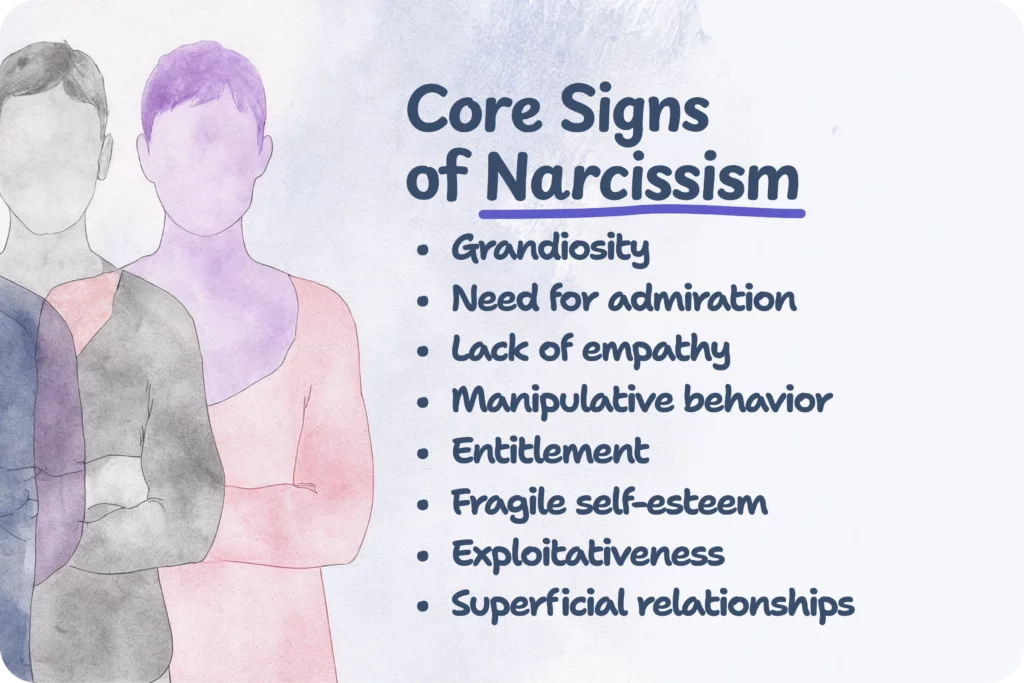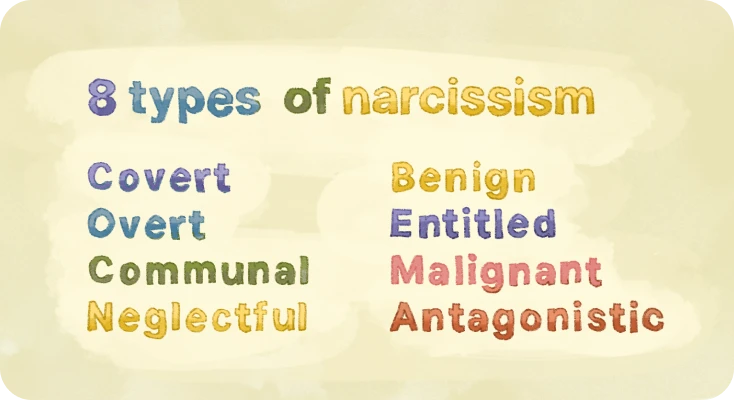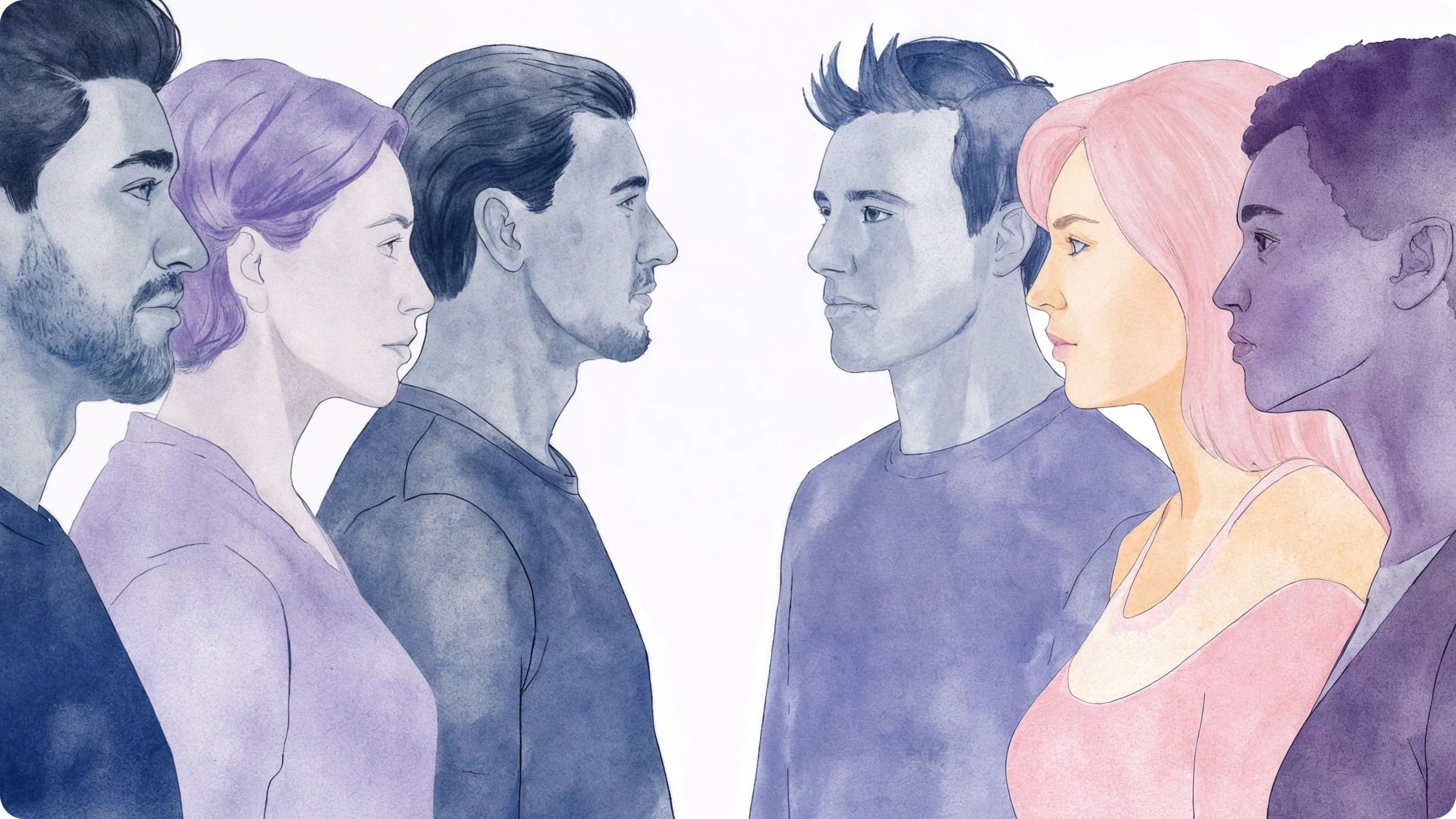Narcissism isn’t always loud, obvious, or wrapped in confidence. In fact, it can show up in subtle, surprising, and even charming ways. From the spotlight-hungry show-off to the quietly self-victimized manipulator, narcissistic traits wear many masks, and recognizing them can help you protect your boundaries, relationships, and peace.
As a former therapist and mental health expert, I often hear people ask about the different types of narcissism. Here’s an overview.
What Is Narcissism?
Narcissism is a pattern of personality traits centered around an inflated sense of self-importance, a strong need for admiration, and difficulty empathizing with others. While many people can show narcissistic tendencies from time to time, narcissism becomes problematic when these traits are persistent and create conflict in relationships, work, or daily functioning.
At its most extreme, it can be diagnosed as Narcissistic Personality Disorder (NPD), but many people show subclinical or “everyday” narcissistic traits without meeting the full criteria, according to research on NPD [1].
Narcissism vs. Narcissistic Personality Disorder (NPD)
Narcissism simply refers to having narcissistic traits. It doesn’t involve a clinical diagnosis. It also doesn’t mean a person is dangerous. Someone acting selfishly or uncaringly doesn’t make them a narcissist. Many of the things we call narcissism are just immaturity or bad manners.
The truth is that we all have some strands of narcissism in our personalities. Fortunately, we can work on them to grow in our mental health and personal relationships.
Narcissistic personality disorder (NPD) is a diagnosable mental health condition. It’s a serious term to throw around because it can negatively impact a person’s relationships, career, and mental health.
There’s also an increased risk of suicide among people with NPD, according to research on the link between NPD and suicidal behavior [3]. This is a serious mental health and mood disorder that often requires intervention.
Adaptive Narcissism vs. Maladaptive Narcissism
Narcissists are generally split between people who can get on with life vs. those who can’t. We call this adaptive narcissism vs. maladaptive narcissism.
A person with adaptive narcissism generally has self-sufficiency, confidence, and other healthy traits that make them able to function in the world. We can call these people high-functioning narcissists. Their narcissistic traits can be useful and helpful when channeled properly.
Many are great when it comes to setting goals at work, being committed in relationships, and having a balanced sense of entitlement. Many confident people you know from real life or the media are probably adaptive narcissists.
Maladaptive narcissism is associated with all of the negative traits of narcissism. This includes entitlement, aggression, lack of empathy, and willingness to use and exploit. They are also more likely to deal with poor mental health, depression, and anxiety. They can still be charming enough to lure you in.
In my experience, one of the big dividing lines is self-esteem. Adaptive narcissists don’t need to force others to praise them because they generally feel good. Meanwhile, maladaptive narcissists are driven by low self-esteem. Their fragile egos spur their dark and manipulative behaviors.
The takeaway is that we can’t just throw labels around. We also can’t put our heads in the sand. Some behaviors truly are red flags. Many narcissists have deep-seated trauma. Painting them with a broad “villain” brush is too simple. However, it’s nobody’s job to save a narcissist.
Core Signs of Narcissism
A study on narcissism defines the following core signs [2]:
- Grandiosity and viewing oneself as special, superior, or more deserving than others.
- Excessive need for admiration, constantly seeking praise, validation, or attention.
- Lack of empathy and difficulty understanding or caring about how others feel.
- Entitlement and expecting special treatment or believing rules don’t apply to them.
- Manipulative behavior and using charm, guilt, or pressure to get what they want.
- Fragile self-esteem and reacting strongly to criticism, even when masked by confidence.
- Boundary violations and disrespecting others’ limits, needs, or autonomy.
- Blame-shifting and refusing to take responsibility.

How Many Types of Narcissists Are There?
The DSM-5-TR doesn’t specify different types of narcissism. However, the general consensus in the mental health community is that there are around eight narcissistic personality disorder types. An individual therapist may operate on the idea that there are 4 types of narcissism, 5 types of narcissism, or even 10 types of narcissists. Like many things, narcissist types exist on a spectrum. Your personal experience can vary widely based on the types of narcissistic traits you encounter.
Here’s a look at different forms of narcissism that are widely recognized:
- Covert or vulnerable
- Grandiose or overt
- Communal
- Neglectful
- Benign
- Entitled
- Malignant
- Antagonistic
Covert, overt, malignant, antagonist, and benign are considered the core narcissistic personality disorder types by most mental health experts.
There are two reasons why you’re interested in narcissistic personality disorder types. The first is that you’ve encountered one. This could be a family member, colleague, or lover. You may wonder, “Why do I attract narcissists?” Answers can include empathy, people-pleasing behaviors, attachment style, and low self-esteem.
The second is that you’re worried you are one. How do I stop being a narcissist? It’s a process that takes introspection. My thoughts as a therapist? All narcissistic tendencies are often rooted in pain. Let’s look a little closer.
8 Types of Narcissism
Whether you’re exploring relationship dynamics, analyzing signs of a female narcissist, or holding a mirror up to yourself, let’s look at narcissist types.
1. Vulnerable or covert narcissist
The covert narcissist is a hard one to pin down. They lack the obvious grandiosity of other types of narcissists. Their introversion conceals self-centeredness and manipulation. We sometimes call this the vulnerable narcissist or closet narcissist. They may even lure you in by making you feel sorry for them.
Typically, people with covert narcissism can play the victim. In doing so, they may have intentions to manipulate your good intentions. Unfortunately, tears and sadness are often mixed with rage and blame. One common trait is a fragile ego. Criticism and rejection are big triggers for people with vulnerable narcissism.
Over time, you may also notice a shocking lack of empathy. While they use self-deprecating humor, they actually have a grandiose sense of self. There’s also a strange conflict between a lack of empathy and altruism for appearances.
Take a covert narcissist test to check your traits! Looking for more quizzes? In the Breeze app, there are a variety of tests on narcissism, childhood trauma, attachment style, emotional intelligence, temperament, and much more.
2. Grandiose or overt narcissist
This is the “classic case” of narcissistic personality disorder types. As a former therapist, I call it big personality, big ideas, and big problems. The overt narcissist often lives life at a higher volume than others. You can easily be drawn into their intensity.
People with overt or grandiose narcissism generally all share an exaggerated sense of self-importance combined with a lack of empathy. However, their surface-level charm makes it hard to know.
Common traits that those in their inner circle will notice include:
- Highly extroverted
- Boastful and braggadocious
- Entitled
- Overbearing
- Quick to take advantage
- Obsessed with getting attention and admiration
- Aggressive when they don’t get what they want
When you are useful to them, they’re ready to move heaven and earth for you. When you’re not, you’re dropped like a ‘hot potato’. This is why therapy is highly recommended if you’ve been caught in a narcissist’s snare.
3. Communal narcissist
Communal narcissists use their social credibility to get what they want. Their charming, outgoing personality gets you to trust them. They are also loved by friends, family, and the community.
Unfortunately, this is one of the most dangerous relationships to be in. Many people who are physically or emotionally abused by communal narcissists stay silent. After all, they are often pillars of the community. They project trustworthiness and honesty.
Intimate partners of people with communal narcissism see what happens when the mask drops. These types of narcissists feel entitled to constant praise. Criticism is met with hostility and aggression. They will also manipulate using antagonism or guilt. They will often coerce to get what they want.
4. Malignant narcissist
Another type of narcissist is the malignant narcissist, who can exhibit dark behaviors. Getting entangled with one can be physically and emotionally dangerous.
Personality traits can include sadism and antisocial behaviors. Here’s a glance at what’s often apparent with malignant narcissism:
- Lack of empathy
- Using others
- Disregard for others
- Attention-seeking behaviors
- Entitlement
- Lack of remorse
- Lying
- Willingness to break the law
- Low impulse control
Malignant narcissists often harm and use others to feed their sense of grandiosity. This can devolve into violence.
What creates malignant narcissists? Many believe that adverse childhood experiences and trauma could foster these traits. Family history is also a potential factor. For example, children of narcissistic parents may be at higher risk. There’s also emerging evidence that people with narcissistic personality disorder (NPD) have differences in brain structure [4].
5. Antagonistic narcissist
Have you ever been in a relationship with someone who constantly picked fights? People with antagonistic narcissism are highly competitive. Relationships are built on competition and predation. There’s always a “winner” and a “loser.” One answer for how to deal with a narcissist like this is to not take the bait.
It’s believed that antagonistic narcissists suffer from disrupted attachment styles. A securely attached person will seek mutually supportive relationships.
Meanwhile, antagonistic narcissists see relationships like this:
- Predation: They see themselves as predators. They see every relationship and interaction as a struggle for dominance. That leaves them entitled to abuse, oppress, intimidate, and violate others.
- Competition: It doesn’t matter if you’re their lover, mother, sibling, or best friend. You are the competition. They will always be competing against you for resources, praise, affection, and respect.
- Parasitism: Antagonistic narcissists are masters at using their victims. They will use whatever social credit or resources you have. This can be as benign as moving into your house while you pay the bills. It can be as dark as coercing you into unwanted sexual relationships.
Hidden abuse is a big problem with this type of narcissism. It’s what we mean when we talk about “gaslighting.” They will use guilt, fawning, praise, and isolation to manipulate. Next to them, you can always ask yourself, “Why do I feel guilty for small things?” Their goal is to get you to break every boundary.
“Punishment” in this dynamic can look like silent treatment, insults, or a threat to leave. However, it’s not always passive-aggressive. Some will hit, physically threaten, or tarnish the name of their victim.
6. Neglectful narcissist
You only exist to a neglectful type of narcissist when they need something. When you have something they need or want, they will pepper you with praise. They often “come and go” from your life.
However, they come around suddenly when they are getting remarried. They are trying to show their new spouse that they are loving and caring toward their kids.
For the child, the sudden attention from a parent they longed for feels good. Yet, it’s performative. The parent may soon disappear once the new relationship or marriage falls apart.
A parent might also swoop back in when the child they’ve abandoned has grown up to have a career. The child now has something of value to offer them. Neglectful narcissism also plays out in romantic relationships.
In my experience, many women who struggled with boomerang relationships were actually dealing with neglectful relationships. They fell hard for “distant” men. Months would go by with no contact. However, a late-night text for a hookup would restart the whole thing.
7. Benign narcissist
Some types of narcissists really don’t want to harm anyone. They aren’t being malicious. However, their immaturity and extreme self-focus can still hurt people.
A benign narcissist can seem like a “dreamer” at first. They exhibit some entitlement and grandiosity. They may also struggle to look beyond their own wants. You might describe them as being “selfish.”
They may also manipulate to get what they want. I’m not sure all benign narcissists even know they’re doing this. They are simply operating on a formula. For example, a benign narcissist may count on their parents to rescue them when they fail to pay their bills.
Benign narcissists are often addicted to validation. Think of people you know who spend all day chasing “likes” on Facebook. Do they even exist if people aren’t commenting about them online?
Here’s where it gets confusing. Many are actually quite extroverted and easy to talk to. They truly don’t want to hurt you. In fact, they aren’t even thinking of you. They are too busy thinking about themselves. The only time the barbs really come out is when they feel attacked.
A common theme with benign narcissists is hypersensitivity. Their addiction to validation can cause them to turn on you when they feel “dissed.”
The biggest frustration with being in a relationship with a benign narcissist is disappointment. Unlike other types of narcissists, they don’t use grand gestures to lure you in. They’re likely to forget your birthday. The good news is that they are unlikely to cause damage.
8. Entitled narcissist
This person skips lines, contradicts themself at every turn, and feels that the rules don’t apply to them. The truth is that entitled narcissists can sometimes be folded into overt or malignant categories. However, I want to give this category some attention because many of my clients have struggled with it.
Entitled types of narcissism believe that they deserve special treatment “just because.” They don’t care if it’s at the expense of others. They also don’t respect boundaries when told “no.”
One of the common themes I’ve seen in people affected by entitled narcissists is self-righteousness. People will use their own morality or “goodness” to justify doing whatever they want. They will also judge others more harshly than themselves.

How to Recover from Relationships with Narcissists
Distressing consequences of narcissistic abuse may show up during a relationship and can persist long afterward. The first signs are intrusive thoughts that cause confusion, anxiety, and fear. According to a study on victims of narcissistic abuse, they may feel lost, not feel like “themselves,” and wonder, “What is wrong with me?” [5]. These constant worries can drain your energy and attention from the important things in your life.
Here are coping strategies for narcissistic abuse recovery:
1. Cut emotional ties and reflect on your emotions
To move on, try to emotionally detach from your ex-partner. Cut off contact and don’t monitor their social media. Take a deep and conscious look at the emotions you’re experiencing around them and the breakup. Try to write them down. These may include confusion, guilt, anger, shame, pain, and loss. You may also experience feelings of loneliness and fear of never finding love again.
Breeze journaling can make the healing process easier by giving you prompts and a private space to release your thoughts. The app can help you learn how to feel your feelings and reconnect with yourself.

2. Make a list of “green flags”
Describe everything you’d like to see in your new partner and your relationship. Focus on traits that indicate emotional availability and maturity, such as honesty, empathy, reliability, and a willingness to communicate. Think about what a supportive, loving relationship feels like for you. It can be mutual respect, shared values, healthy conflict resolution, and consistent care.
Return to this green flags in relationships list when you feel ready to date. Alongside your green flags, you can note behaviors you want to avoid to focus on what’s important and maintain boundaries.
3. Focus on yourself and your future
The final part of recovery is shifting your focus from your partner and your shared past to yourself and your future:
- Create a mental picture of who you’d like to be in a relationship: what your goals and needs are?
- Practice making decisions for yourself and trusting your judgment without seeking approval or validation from a partner.
- Prioritize activities that boost your confidence and emotional well-being, such as exercise, hobbies, learning new skills, or spending time with supportive people and making new friends as an adult.
- Try personalized Breeze affirmations to replace old patterns of self-blame or doubt with empowering positive statements. For example, you might remind yourself daily: “I am worthy of love and respect,” or “I trust myself to make healthy choices for my future.”

4. Consider therapy to speed up a recovery
Working with a licensed mental health professional can give you guidance, support, and healthy coping strategies to help you heal more effectively after a narcissistic relationship.
Frequently asked questions
1. Are all narcissists the same?
No. Narcissism shows up in different styles, motivations, and behaviors. Some narcissists are grand and attention-seeking, while others are quiet, fragile, or even self-sacrificing on the surface. That’s why breaking it down into types helps make the patterns easier to recognize.
2. Is narcissism the same as confidence?
Not at all. Confidence is grounded in healthy self-worth, while narcissism relies on external validation. Confident people don’t need to diminish others to feel good. Narcissists often do.
3. Can a narcissist change?
Change is possible but challenging. It typically requires long-term therapy and a willingness to acknowledge harmful behaviors, while many narcissists struggle with changes because they threaten their exaggerated self-image.
Sources
- Weinberg I, Ronningstam E. Narcissistic Personality Disorder: Progress in Understanding and Treatment. October 2022
- Grapsas S, Brummelman E, Back MD, Denissen JJA. The “Why” and “How” of Narcissism: A Process Model of Narcissistic Status Pursuit. January 2020
- Daniel Coleman, Ryan Lawrence, Amrita Parekh, Hanga Galfalvy, Hilario Blasco-Fontecilla, David A. Brent, J. John Mann, Enrique Baca-Garcia, Maria A. Oquendo. Narcissistic Personality Disorder and suicidal behavior in mood disorders. February 2017
- Igor Nenadić, Carsten Lorenz & Christian Gaser. Narcissistic personality traits and prefrontal brain structure. August 2021
- Nevicka B, De Hoogh AHB, Den Hartog DN, Belschak FD. Narcissistic Leaders and Their Victims: Followers Low on Self-Esteem and Low on Core Self-Evaluations Suffer Most. March 2018
Disclaimer
This article is for general informative and self-discovery purposes only. It should not replace expert guidance from professionals.
Any action you take in response to the information in this article, whether directly or indirectly, is solely your responsibility and is done at your own risk. Breeze content team and its mental health experts disclaim any liability, loss, or risk, personal, professional, or otherwise, which may result from the use and/or application of any content.
Always consult your doctor or other certified health practitioner with any medical questions or concerns
Breeze articles exclusively cite trusted sources, such as academic research institutions and medical associations, including research and studies from PubMed, ResearchGate, or similar databases. Examine our subject-matter editors and editorial process to see how we verify facts and maintain the accuracy, reliability, and trustworthiness of our material.
Was this article helpful?






